 Once again, it's that time of year when the holiday spirit is in the air: the time when you start hearing those old songs and seeing those pretty lights (not to mention the shopping crowds and the bad weather.) But for lots of us, along with all the good cheer comes a measure of holiday-induced stress. In all the hustle and bustle of the season, could your teeth be suffering from holiday stress too?
Once again, it's that time of year when the holiday spirit is in the air: the time when you start hearing those old songs and seeing those pretty lights (not to mention the shopping crowds and the bad weather.) But for lots of us, along with all the good cheer comes a measure of holiday-induced stress. In all the hustle and bustle of the season, could your teeth be suffering from holiday stress too?
We're not just talking about what may happen when you bite down on an uncooked kernel in a popcorn ball, or use your mouth to do what you should be doing with a nutcracker — although that certainly does occur. But for many people, the holidays are a time when we're eating lots of sugary snacks and rushing around without really taking care of ourselves. In fact, people in recent surveys have said they expect to gain an average of about five pounds during the season (although their actual weight gain is probably less.)
Still, that's a lot of extra calories — and many come from the sugar in holiday treats. Aside from the added weight (which may be hard to take off), this can create a host of dental problems, including one very common — and preventable one — tooth decay. Here are a few friendly reminders about how you can prevent your teeth from “stressing out.”
If you're going to indulge in some sweet treats, wait until after a meal — but resist between-meal snacks, and don't feed your sweet tooth right before bed. Why? It's all because of your saliva! Saliva is the body's natural way of neutralizing acids in the mouth that promote tooth decay — but it takes about an hour to work. If you're constantly putting sugars in your mouth, your saliva has no time to do its job.
What if you brush your teeth right afterward? You might think this would be effective, but research shows otherwise. Sugar creates acid, and acid softens tooth enamel, which helps protect your teeth from decay. After acid attack, enamel can take 30-60 minutes to re-harden. If you frequently brush while the enamel is soft (more than twice per day), you might actually begin brushing enamel away. So too-frequent brushing may do more harm than good.
What's the good news? Fluoride toothpaste, used properly, is effective at preventing cavities. Calcium, which is often added to beverages as a nutritional supplement, may also help protect tooth enamel. And — perhaps surprisingly — eating cheese may also be beneficial, as it too can help neutralize acids in the mouth.
So pass on the candy canes, enjoy the cheese plate — and have a happy holiday!
If you have questions about tooth decay or oral hygiene, contact Dr. Cindy Sumarauw at 801-281-3500 to schedule an appointment for a consultation. You can learn more in the Dear Doctor magazine articles “Tooth Decay” and “Oral Hygiene Behavior.”

 The holidays are traditionally a time when friends and family from near and far can get together and make merry. In this joyful season, many folks look forward to re-connecting with old friends… and maybe making new ones. But if you've been hesitant to show your holiday smile because your teeth are less than pearly white — then why not stop fretting: Did you know that your teeth could be dramatically brighter after just one visit to the dental office?
The holidays are traditionally a time when friends and family from near and far can get together and make merry. In this joyful season, many folks look forward to re-connecting with old friends… and maybe making new ones. But if you've been hesitant to show your holiday smile because your teeth are less than pearly white — then why not stop fretting: Did you know that your teeth could be dramatically brighter after just one visit to the dental office?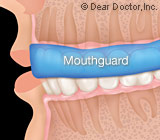 Participating in athletic activities offers numerous well-documented health benefits — not to mention instilling the intangible values of discipline, teamwork and goal-setting. Of course, in nearly every sport, the possibility of injury exists as well. But don't let that stop you or someone you love from playing! Instead, you can learn about the potential hazards of dental injury, and take some practical steps to minimize the risk.
Participating in athletic activities offers numerous well-documented health benefits — not to mention instilling the intangible values of discipline, teamwork and goal-setting. Of course, in nearly every sport, the possibility of injury exists as well. But don't let that stop you or someone you love from playing! Instead, you can learn about the potential hazards of dental injury, and take some practical steps to minimize the risk. Plenty of parents use little tricks to persuade young ones to eat their vegetables, wash their hands, or get to bed on time. But when actress Jennie Garth wanted to help her kids develop healthy dental habits, she took it a step further, as she explained in a recent interview on Fox News.
Plenty of parents use little tricks to persuade young ones to eat their vegetables, wash their hands, or get to bed on time. But when actress Jennie Garth wanted to help her kids develop healthy dental habits, she took it a step further, as she explained in a recent interview on Fox News. If you've recently had a
If you've recently had a  Singer Olivia Newton-John's daughter Chloe is now a lovely, grown woman, but Olivia recently recounted to Dear Doctor magazine a rather creative method she found to sooth Chloe's teething troubles many years ago.
Singer Olivia Newton-John's daughter Chloe is now a lovely, grown woman, but Olivia recently recounted to Dear Doctor magazine a rather creative method she found to sooth Chloe's teething troubles many years ago.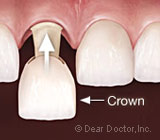 A crown is a common type of dental restoration that has been available, in different forms, for a long while. When properly done, it may last for decades — and if desired, it can be made to match the shade of the natural teeth so well that it's nearly impossible to tell them apart. Some recent technological innovations may offer patients who need this treatment even more choices. To begin learning about
A crown is a common type of dental restoration that has been available, in different forms, for a long while. When properly done, it may last for decades — and if desired, it can be made to match the shade of the natural teeth so well that it's nearly impossible to tell them apart. Some recent technological innovations may offer patients who need this treatment even more choices. To begin learning about  Lashinda Demus holds the U.S record in the 400 meter hurdles, with a time of 52.47 seconds, the third fastest ever recorded. While her twin 5-year-old boys cheered her on, she brought home a silver medal from the 2012 London Olympics. But when it comes to her full set of upper and lower braces, there's no silver to be seen!
Lashinda Demus holds the U.S record in the 400 meter hurdles, with a time of 52.47 seconds, the third fastest ever recorded. While her twin 5-year-old boys cheered her on, she brought home a silver medal from the 2012 London Olympics. But when it comes to her full set of upper and lower braces, there's no silver to be seen!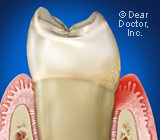 Periodontal or gum disease is an often silent disease that can cause significant damage to the health of your teeth and body. The reason it is so often classified as a silent disease is because it is chronic or longstanding and often without any symptoms or pain that most people associate with a disease until it may be too late.
Periodontal or gum disease is an often silent disease that can cause significant damage to the health of your teeth and body. The reason it is so often classified as a silent disease is because it is chronic or longstanding and often without any symptoms or pain that most people associate with a disease until it may be too late.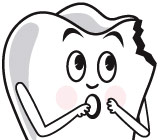 Nearly every parent and caregiver has experienced that almost instantaneous sick feeling when they see that their child has been injured, especially when it is an injury to the mouth and teeth. For some, it is just a bloody lip; however, if the accident chipped a tooth, then you may have a completely different situation on your hands. If the nerve of the tooth has not been damaged, you needn't worry too much — a composite (plastic) tooth-colored restoration that is actually bonded to the tooth is an ideal material for repairing most broken or chipped teeth. Contact Dr. Cindy Sumarauw at 801-281-3500 as soon as possible to assess the extent of injury, so that proper and appropriate action can be taken.
Nearly every parent and caregiver has experienced that almost instantaneous sick feeling when they see that their child has been injured, especially when it is an injury to the mouth and teeth. For some, it is just a bloody lip; however, if the accident chipped a tooth, then you may have a completely different situation on your hands. If the nerve of the tooth has not been damaged, you needn't worry too much — a composite (plastic) tooth-colored restoration that is actually bonded to the tooth is an ideal material for repairing most broken or chipped teeth. Contact Dr. Cindy Sumarauw at 801-281-3500 as soon as possible to assess the extent of injury, so that proper and appropriate action can be taken.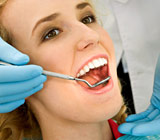 Let's talk about oral cancer. Yes, it's a scary subject — but the truth is, the more you know about it, the better able you are to protect yourself.
Let's talk about oral cancer. Yes, it's a scary subject — but the truth is, the more you know about it, the better able you are to protect yourself. Many adults these days are opting for clear aligners to correct orthodontic problems that have long bothered them. Katherine Heigl is a perfect example. She had one tooth that was out of alignment, and wanted to have it fixed before her wedding day.
Many adults these days are opting for clear aligners to correct orthodontic problems that have long bothered them. Katherine Heigl is a perfect example. She had one tooth that was out of alignment, and wanted to have it fixed before her wedding day.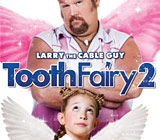 Did you know that severe tooth decay is America's #1 chronic childhood disease? Actress Brady Reiter didn't know either — until she became the star of the movie Tooth Fairy 2, and then joined forces with the National Children's Oral Health Foundation: America's ToothFairy®.
Did you know that severe tooth decay is America's #1 chronic childhood disease? Actress Brady Reiter didn't know either — until she became the star of the movie Tooth Fairy 2, and then joined forces with the National Children's Oral Health Foundation: America's ToothFairy®. Teeth whitening is an extremely popular remedy for a lackluster smile, and with good reason: It works! So what's the best way to whiten teeth? We recommend
Teeth whitening is an extremely popular remedy for a lackluster smile, and with good reason: It works! So what's the best way to whiten teeth? We recommend  Whether you are an existing patient or searching for a dentist, we’re excited you are here. With the dental industry advancing, we recognize the importance of keeping our patients and visitors up to date with all of the new and exciting things taking place in our practice.
Whether you are an existing patient or searching for a dentist, we’re excited you are here. With the dental industry advancing, we recognize the importance of keeping our patients and visitors up to date with all of the new and exciting things taking place in our practice.